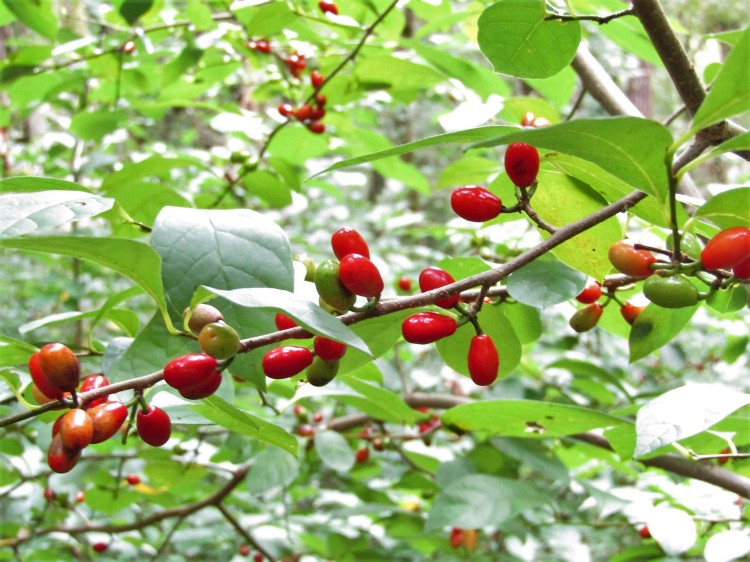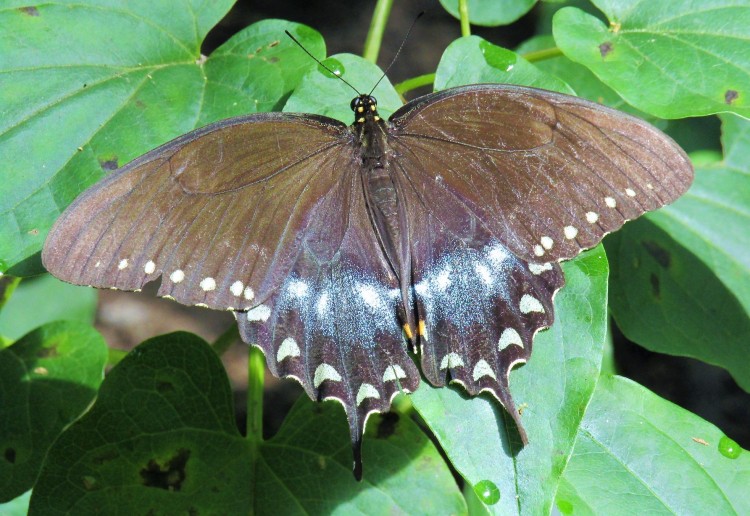
If you’re a migrating hummer looking for a place to refuel, the value of good habitat is immeasurable. Hummingbirds can travel about 20 miles a day, so our little forest is a haven in the midst of urban sprawl. An abundance of Spotted Jewelweed is the main draw during fall migration – hummers can both nectar and forage for insects before moving on.


This Stinkbug nymph and Yellow Woolly Bear caterpillar like feeding in the jewelweed patch too, and would not be on a hummingbird’s menu.


All neotropical migrants need high quality habitat along their route to survive the rigors of migration. A diverse forested environment with a range of micro habitats will meet the needs of the greatest variety of migrating birds. This is one of the more important functions of the many little forest fragments stranded in the urban/suburban matrix.

One high quality food item our forest can increasingly provide is lipid-rich Spicebush berries.

Groves with lots of ripe berries get mobbed by robins in fall; they’re the place to hear and occasionally see other thrushes too. (Listen for the low “chuck” note of skulking Hermit thrushes.) This great link has more on the importance of high quality urban habitat for migrants: https://ufi.ca.uky.edu/treetalk/neotropical-birds

Whether it’s a brushy tangle or heaps of rotten wood, resident birds need the right habitat to thrive too. As more and more ash trees die and eventually come crashing down, woodpeckers reap the harvest.

Despite the potential high value (to wildlife and humans) of urban nature preserves, their habitat possibilities are often not developed. Urban woodlands have to cope with a unique set of challenges – in our case it’s stormwater disturbance and erosion, a heavy infestation of invasive plants, and and a growing, unchecked deer population. These impacts mean a more intensive style of management is needed to create, and then maintain high quality diverse habitat. And as with many other small forest fragments, the preserve depends on a non-profit nature center and an underfunded state agency, neither of which have the resources to give it this kind of care.

The domination of this forest by Bush Honeysuckle, in particular, has reduced the diversity of native plants to those that can live in heavy shade. Though the plants provide basic habitat of a sort, in the form of cover and abundant berries, they create a barren monoculture that prevents forest regeneration. Removing them leaves the landscape standing bare and primed for re-invasion – hence the need for intensive planting and ongoing management.
Interestingly, not everyone believes invasive plants are a problem. There’s a school of thought that goes like this – we ought to embrace highly altered, or “novel” ecosystems for what they are, since invasive plants are the most successful in degraded and disturbed environments. Trying to restore one’s vision of what the historical flora may have been is pointless and doomed to failure. In my wearier moments I almost agree. Novel landscapes will certainly dominate more and more, and invasive plants and animals tend to be very successful in disturbed ecosystems.
Despite this I believe it’s possible to restore sustainable, largely native habitat – but it requires pragmatic choices and an ongoing commitment. Such habitat is undeniably of greater value to wildlife. For example – butterflies, moths, their larval foodplants and the ones they pollinate, have all coevolved and share an intricate relationship. This is something that can’t be replicated in a landscape of mostly invasive plants.

What makes for sustainability in a native plant community that will be up against non-native plants and deer? It’s important to understand which native plants are most competitive and why. While I’d like to see a wide diversity of native shrubs flourish in this forest, only a few have what it takes to succeed in such a challenging environment. With deer browsing a real limitation, it’s evident that non-browsed Spicebush, Lindera benzoin and Pawpaw, Asimina triloba will be the real winners.

Both plants are very high value for habitat, producing berries and fruit, and serving as the foodplants for butterfly larvae. And they have other characteristics that help them succeed in this somewhat novel environment. Pawpaw can grow from seed and hang out as a very small plant in the deep shade of Bush Honeysuckle, waiting for a gap to open up. Now that we’re felling the shademakers, numerous Pawpaw groves will be able to grow to maturity, spreading clonally to take their place in the understory.

Spicebush competes in the same arena as Bush honeysuckle – both are widely branching, medium to large shrubs with abundant red berries. Unlike Bush honeysuckle, Spicebush foliage is not dense enough to suppress other plants – in fact its low spreading branches can shelter more tasty plants from deer. As with Bush honeysuckle, birds do the job of seed dispersal, and in this forest’s moist soils Spicebush recruits from seed as easily as Bush honeysuckle. It’s also easy to plant as a bare root and grows quickly when young.

Today I noticed that most of the Spicebush berries were already devoured in an abundantly fruiting grove near post #18. This was great to see, since in years past they lingered on the bush longer due to the relative abundance of honeysuckle berries. With much less Bush honeysuckle around, Spicebush berries are more covetted. I’m hoping for the day when Spicebush dominates the shrub layer throughout the forest, creating a high value food source, and a sustainable barrier to Bush honeysuckle re-invasion.

When it comes to urban forest fragments, quality is worth as much, or more, than quantity. At a bit less than 80 acres, this is a small forest, but its potential value to wildlife, especially birds, is huge. Through the dedicated work of the Forest Stewards, more and more areas of high quality habitat are being revived each year. It’s a long-term commitment, and once started needs to be followed through. Hopefully someone will always want to do it. But if our community values the joy of co-existing with wild creatures, and a rich, diverse forest community – the work will go on.

debbie utz
I have driven KY back roads and in neighboring states often this year and invasive plants certainly seem to be flourishing. Along roadsides they are taking over native types of plants. Thanks for your work to keep invasives in check and replanting/encouraging growth of native foliage. Last week at LNC I saw an amazing number of hummingbirds, all busy in the nectar search. So you are making a positive change! Thanks.
LikeLiked by 2 people
oneforestfragment
Thanks Debbie! Hopefully the continuing planting of Spicebush will result in a sustainable, stable understory community. I was collecting Jewelweed seed today, it is still blooming as it produces seed, due to the moisture and late warmth.
LikeLike
Marianna metcalf
You have such a wonderful blog. Together with the pictures you really take us on a mini tour and alert us to what’s happening. Great Read!
LikeLiked by 1 person
Michael Smith
I saw six deer last night I think someone is feeding some of them. Would that help keep them away from native plants?
LikeLiked by 1 person
oneforestfragment
It might, but they still need green stuff. Habitat improvement over the whole forest can help supply more of it for them to eat, so they don’t overbrowse certain things.
LikeLike
oneforestfragment
Thanks Mariana! Having to take the pics keeps me alert too, and on the lookout for all the little occurences I might otherwise miss.
LikeLike
j3w3lw33d
The pro-invasive school of thought is complete and total speculation. I also see where this is coming from and can respect that aspect of it but we must do everything we can to preserve as much habitat as we can for the species that we are trying to save! The hard and rigorous work that you are doing should be a model for others! I am very proud of the work that you are doing! In Philly we are getting ready to work on a new area of a degraded urban Forest near our house.
LikeLike
oneforestfragment
Thank-youI I have been inspired by your work as well, but had lost track of your blog (just refound it). Urban forests are amazing places with such great potential, particularly when there are people who commit to their revival. Look forward to hearing how the work goes.
LikeLiked by 1 person
tonytomeo
Although restoration of a totally native ecosystem might be futile, particularly in urban regions, invasive exotics should not be protected like they are. In our isolated places in our region, the wickedly invasive blue gum is protected because the monarch butterflies swarm to them. The problem is that the swarming monarch butterflies are ignoring other flora that rely on them for pollination. It would be impractical to remove all the blue gums, but the trees should certainly be a very low priority when choosing between them and the native or nearly native pines and cypress.
LikeLiked by 1 person
oneforestfragment
Yes, that reminds me of how we ended up with so much Bush Honeysuckle, one of the main shrubby invasives in the midwest. It was promoted by the USDA as good for wildlife among other things. Birds certainly do love it the berries, that’s the problem!
LikeLiked by 1 person